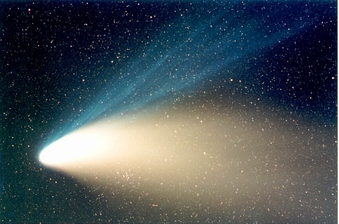 |
 |
 |
 |
 |
 |
 |
 |
|
 |
 |
 |
60 Short-period comets
|
| Menu | back |
Our solar system contains far fewer short-period comets with an orbital period of between twenty and two hundred years (Halley-type comets) than comets with an orbital period of less than twenty years (Jupiter comets). Only one percent of the Halley-type comets anticipated according to calculations can actually be observed. This is far too low for the concept of a billion-year-old solar system into which new comets enter continuously. They then orbit around the sun, starting from long-periods, in continuously shorter orbits.
|
 |
|
Comet Halley
|
| Comets are small and irregularly shaped celestial bodies consisting of gaseous and solid particles. The actual body, the so-called nucleus of the comet, consists of ice (frozen carbon monoxide, carbon dioxide, methane, and aqueous ice) and dust and is frequently compared with a dirty snowball. Comets can have diameters from approximately 1 to 100 km. They move in highly eccentric orbits which can bring them very close to the sun and then sling back out far into space.
As a comet approaches the sun, it heats up and the ice on its surface evaporates. This results in development of the sensational tail. During each orbit around the sun, the comet loses the material of its tail. At the end, it disintegrates completely.
The short-period comets have a life expectancy of 50,000 to 500,000 years. This poses the question of why we still have in our planetary system (which is allegedly billions of years old) so many short- period comets. To solve the problem, a theoretically present Oort cloud is proposed which allegedly continuously supplies new comets.
Oort cloud:
In 1950, the astronomer Jan Hendrik Oort postulated that our solar system could be surrounded by a cloud containing many billions of small comets. He picked this proposition up from astronomer Ernst Öpiks theory advanced in 1932. Oort believed that a star occasionally passes by our solar system throwing one of the comets out of its orbit and catapulting it into the interior of the solar system. However, there is
a) no direct verification for the Oort cloud. Its existence is purely theoretical, and
b) if such a cloud did exist and a comet was now and then actually deflected into the inside of our solar system, it is nevertheless highly improbable that it would enter into a short-period orbit.
Fading problem (1):
The gravitation of the large planets influences the orbits of new long-period comets with an orbital period of greater than 200 years which enter the solar system, to change to such an extent, that they either would be hurled out of the solar system after the first pass or enter into a significantly closer orbit.
If new long-period comets had appeared continuously for hundreds of thousands of years, we would expect to find a large number of comets of the Halley type. Nevertheless, very few Halley type comets have been observed.
Prograde and retrograde comets (2):
It is not possible to explain satisfactorily the large difference in the frequency of occurrence of the various types of comets. For example, the frequency of prograde comets (those rotating clockwise) and retrograde comets (those moving in the opposite direction) does not agree with the calculations. The ratio among long-period comets observed is around at 50:50.
Dynamic calculations indicate that prograde comets have a significantly higher chance of being catapulted out of the solar system by the large planets. Therefore, we expect to find approximately twice as many retrograde comets as prograde. However, the ratio is 50:50. This indicates that the prograde comets have been exposed to the danger of being thrown out of the solar system for only a few thousand years.
These 61 | Menu |
back
|
References:
|
| (1) |
Peter Korevaar, Die rätselhafte Oortsche Wolke, Studium Integrale 2002/9, pages 7982. |
| (2) |
Paul A. Wiegert, The evolution of long-period comets, Dissertation, University of Toronto, 1996. | |
| |
| (Image) http://mediatheek.thinkquest.nl/~lld049/index2.php?page=akomeet&plan=Astronomie,%20heelal,%20beginner |
| |
Comment this Site!
|
 |
 |
 |
 |
|

